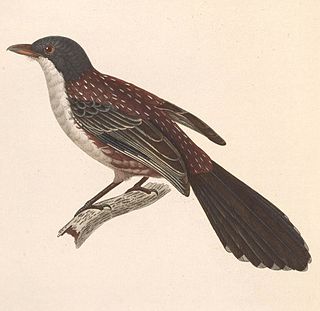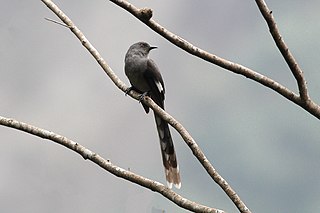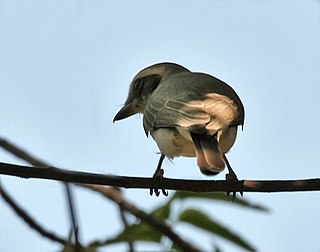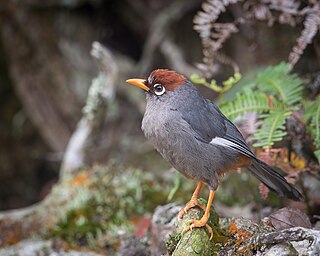
Garrulax is a genus of passerine birds in the laughingthrush family Leiothrichidae.

The red-billed leiothrix is a member of the family Leiothrichidae, native to southern China and the Himalayas. Adults have bright red bills and a dull yellow ring around their eyes. Their backs are dull olive green, and they have a bright yellow-orange throat with a yellow chin; females are somewhat duller than males, and juveniles have black bills. It has also been introduced in various parts of the world, with small populations of escapees having existed in Japan since the 1980s. It has become a common cagebird and amongst aviculturists it goes by various names: Pekin robin, Pekin nightingale, Japanese nightingale, and Japanese (hill) robin, the last two being misnomers as it is not native to Japan.

The liocichlas are a group of birds in the genus of the same name, Liocichla, from the family Leiothrichidae. They are found in Asia from India to China. They belong to a clade also containing at least the Leiothrix, the barwings, the minlas and the sibias. Among these, they are an early offshoot, or basal lineage.

Selasphorus is a genus of hummingbirds from Middle and North America.

Turdoides is a genus of passerine birds in the laughingthrush family Leiothrichidae. The species are distributed across Africa and southern Asia and are typically fairly large, long-tailed birds which forage in noisy groups. The majority of species have drab brown or grey-brown plumage. Several species that were included in Turdoides in the past have been reassigned to Argya following a 2018 study that found multiple clades.

The spotted crocias is a passerine bird in the family Leiothrichidae. It is endemic to the island of Java in Indonesia, where it is confined to west Java.

Laniellus is a genus of passerine birds in the family Leiothrichidae.
The grey-crowned crocias is a passerine bird in the family Leiothrichidae. It is endemic to Vietnam, where it has a highly restricted distribution in the Da Lat Plateau. It has also been observed, and independently surveyed in 2015, in Central Vietnam on the Kontum Plateau, where it may be more abundant. Its natural habitat is intact broadleaf evergreen forest and secondary forest, generally near watercourses, between 910–1450 m above sea-level.

The rufous-backed sibia is a passerine bird in the family Leiothrichidae.

The long-tailed sibia is a species of Leiothrichidae from Southeast Asia. The species was once placed in the large family Timaliidae, but that family is sometimes split with this species being placed with the laughingthrushes in the family Leiothrichidae. The species is sometimes treated as the only species in the genus Heterophasia, with the other species being placed in the genus Malacias.

Phoenicircus is a genus of birds in the family Cotingidae. They have a bright red breast, crown, tail, and rump with the Guianan species having dark brown wings and the black-necked species having black wings. They are frugivores, eating primarily berries and drupes.

Tephrodornis is a bird genus in the family Vangidae.

Cyanoderma is a genus of passerine birds in the Old World babbler family Timaliidae. Many of these species were formerly placed in the genus Stachyris

Zosterornis is a genus of passerine birds in the white-eye family Zosteropidae. The five species in the genus are endemic to the Philippines.

The dark-backed sibia is a bird species in the family Leiothrichidae. In former times it was included the black-headed sibia, H. desgodinsi. Together with most other sibias, it is sometimes separated in the genus Malacias. It is found in China, Myanmar and Thailand. Its natural habitat is subtropical or tropical moist montane forests.

Argya is a genus of passerine birds in the family Leiothrichidae. The species are distributed across Africa and southern Asia and are typically fairly large, long-tailed birds that forage in noisy groups. Members of this genus were formerly placed in the genera Turdoides and Garrulax.

The laughingthrushes are a family, Leiothrichidae, of Old World passerine birds. They are diverse in size and coloration. These are birds of tropical areas, with the greatest variety in Southeast Asia and the Indian subcontinent. The entire family used to be included in the Old World babbler family Timaliidae.

Lyrurus is a genus of birds in the grouse subfamily. They are known as black grouse because the male's plumage of both species is colored black as its base colour.

Pterorhinus is a genus of passerine birds in the laughingthrush family Leiothrichidae.

Mixornis is a genus of passerine birds in the Old World babbler family Timaliidae.



















